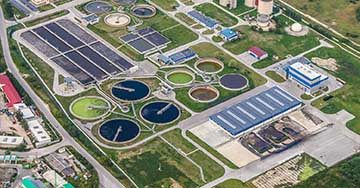September 22, 2020

Researchers hope to predict and promote algae growth at wastewater treatment plants such as this one to purify water sources.
Two Mizzou Engineering departments have teamed up to develop a new computer model that will predict algae growth. The research has the potential to increase algae production—and that could lead to cleaner water supplies.
Students and faculty from the Department of Electrical Engineering and Computer Science (EECS) and Civil and Environmental Engineering (CEE) are conducting the research. The group recently published its findings in the Science of the Total Environment, a top environmental journal.
Algae is known to absorb pollutants such as prescription drugs, cosmetics, cleaners and other harmful chemicals that seep into our drinking water.
“The main topic of this project concerns everyone,” said Feng Feng, a post-doctoral fellow in EECS. “Industrialization and increased pollution strain the availability and quality of water resources worldwide. There is an urgent need for a solution, and algae is a promising solution.”

Feng
While clean water is primarily an environmental engineering problem, Feng said the computer model can make valuable predictions that go beyond current experiments. And that could lead to increased algae production in wastewater treatment facilities.
“It’s much more promising than current strategies used to purify water,” Feng said.
Adjusting External Factors
Previous studies into algae have mostly focused on how it grows from a cellular level. What’s different about this study, Feng said, is that it considers external factors such as sunlight and biomass concentration, from a macroscopic perspective.
“We’ve developed computer-based models that simulate algae growth so we’re able to find which factors can be adjusted,” he said.
The team is testing those models using an algae membrane bioreactor in the lab of CEE Professor Zhiqiang Hu.
“The model can be used for algae that is cultivated in the membrane bioreactor,” said Yan Li, who is pursuing a PhD in Civil Engineering. “First, we build a new model, then the new model can be used in the membrane bioreactor. I hope we can use the model to forecast productivity of the algae instead of using experiments. Experiments usually need several months to get productivity results.”
The group has also tested the models in an outdoor setting using water from the city of Columbia’s wastewater treatment facility.

Li
The next step is to look at additional factors impacting growth, Feng said.
“We didn’t consider the comprehensive list of factors—there are so many factors,” he said. “Next, we will be testing models that are more practical in reflecting real scenarios.”
Ultimately, Feng said the group hopes the findings can provide guidelines that will allow wastewater plant operators to boost algae growth at treatment plants.
“The merit of this study is that it is a simple model that can be easily and practically implemented with no heavy burden on computing resources. It’s also very easy to use and can guide facility operators on how to set up operational factors in the cultivation system to reach maximum algae productivity.”
In addition to Feng and Hu, other contributors to the article include:
- Benjamin Latimer, a graduate student in electrical engineering and computer science.
- Chiqian Zhang, a research technician in civil engineering.
- Satish S Nair, a professor in electrical engineering and computer science.
The article will be published in the January 2021 print issue of Science of the Total Environment. It is available online here.